May 21, 2025 | 09:38 GMT +7
May 21, 2025 | 09:38 GMT +7
Hotline: 0913.378.918
May 21, 2025 | 09:38 GMT +7
Hotline: 0913.378.918
Mr. Nguyen Van Luan was born and raised in a farming family in Son Giang commune, Huong Son district, Ha Tinh province. In 1987, he and his family went to Muong Xen town, Ky Son district, Nghe An province, to start a business with many jobs to make a living.
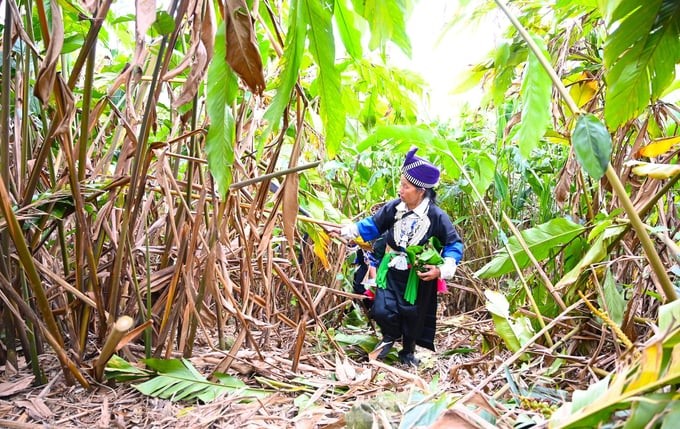
Ginger in Ky Son has very good quality and is favored in the market. Photo: Ngoc Tu.
By 1999, he realized that in Ky Son land, there was a great need for an agricultural services and handicrafts cooperative to serve ethnic farmers in villages with conditions to contact, trade, and exchange agricultural products produced by them, especially in highland villages bordering Vietnam and Laos, such as Muong Long, Huoi Tu, Tay Son, Ta Ca, and Dooc May communes. In these communes, he saw that the villagers' lives were extremely difficult. People produced many products, such as Shan Tuyet tea, ginger, silkie (black chicken), Mong beef, etc., but did not know where or to whom to sell their products.
From his thoughts and what he saw in his hometown of Ky Son, Mr. Nguyen Van Luan boldly established the Huong Son Agricultural Services & Handicrafts Cooperative, of which he was directly the director, to both do business and serve farmers in agricultural production. The Cooperative’s first job was to purchase and consume ginger products for the villagers.
To sell ginger, Mr. Luan had to dig up whole ginger clusters in the villages' mountain fields by himself, wash them, and bring them to traders to offer. Fortunately, Ky Son ginger was favored by traders inside and outside the province because the ginger here is low in fiber, fragrant, and very spicy, so traders bought it more and more.
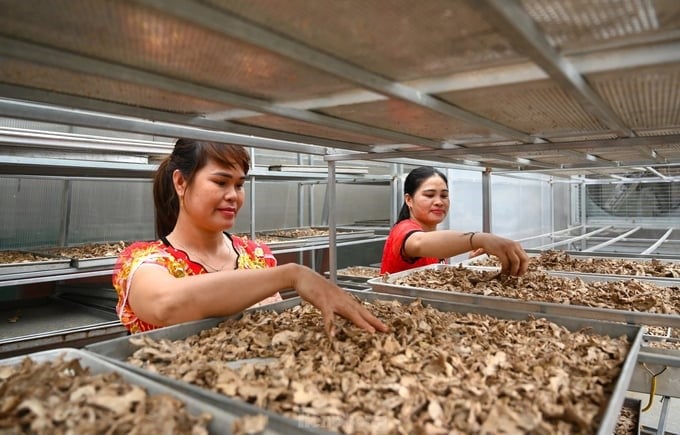
Mr. Luan has invested in a methodical equipment system to serve ginger processing for export. Photo: Ngoc Tu.
Realizing the potential of Ky Son ginger trees to help villagers eliminate hunger and reduce poverty while also being suitable for the Cooperative's business purposes, in 2013, Mr. Luan began to find out how many ginger varieties farmers were growing, which varieties had the highest yield, growing seasons, growing techniques, etc.
Accordingly, he learned that in Ky Son there are two ginger varieties, including De ginger with a small root, low yield, but very spicy taste, and Sung Trau ginger with a large root, high yield, low fiber, and less spicy taste than that of De ginger. All of these two types of ginger were bought by customers.
The weakest thing about ginger production in Ky Son is low productivity due to poor investment in intensive farming and a lack of methods to choose good root seeds when planting. Therefore, Mr. Luan had to find district and provincial agricultural technical staff and read books to master the basic knowledge of growing ginger intensively with high productivity. Since then, before each ginger-growing season, he has invited technical staff and agricultural experts from the district and province to train villagers on how to plant, care for, prevent pests, harvest, and preserve ginger. Among them, according to Mr. Luan, the most important measure is to not break or crush the ginger when harvesting to preserve it for a long time.
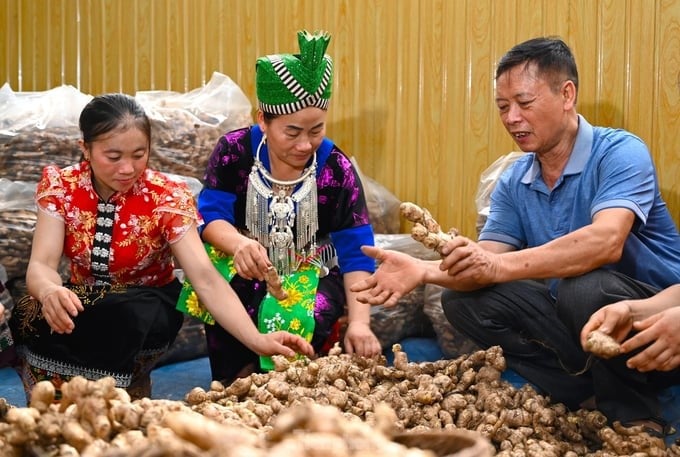
Thanks to Mr. Luan (far right), hundreds of highland households in Ky Son have had a good income from ginger. Photo: Ngoc Tu.
Initially, the Cooperative mobilized 20 households to join in the linkage of growing 10 hectares completely following the organic ginger production process. By 2023, the Cooperative had 146 households in 6 villages in 4 communes in Ky Son district (Tay Son, Ta Ca, Muong Long, and Dooc May) participating in growing ginger on an area of 40 hectares.
Thanks to the application of science and technology in production, from growing to harvesting, the average ginger yield reaches 30 tons/ha, the highest ever. In particular, ginger is grown at an altitude of over 1,200m, so it is very spicy and fragrant and is favored and bought by many customers. It is estimated that the average income from 1 hectare of ginger is about VND 200 million, 10 times higher than that of growing corn and rice on burnt-over land.
As of now, the ginger production and consumption linkage model between villagers and Huong Son Agricultural Services & Handicrafts Cooperative has expanded to an area of up to 400 hectares in many communes in Ky Son district and expanded to some communes in Tuong Duong district such as Nhon Mai and Mai Son, which are poor communes bordering Vietnam and Laos. Initially, these communes regularly provided the Cooperative with 40–45 tons of ginger root/year.
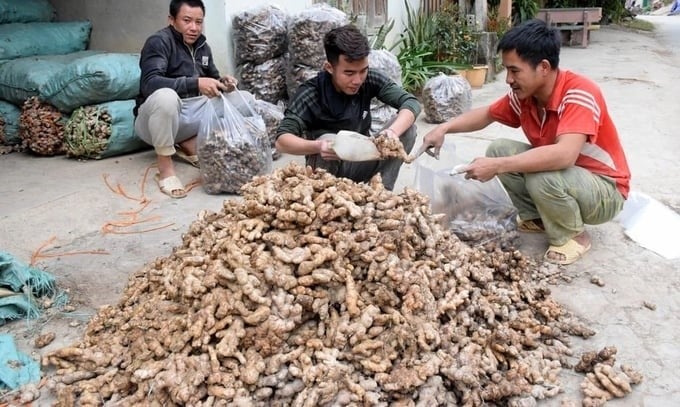
With the advantage of quality, Ky Son Ginger has created a brand. Photo: Xuan Hoang.
Currently, Huong Son Agricultural Services & Handicrafts Cooperative is a unit specializing in purchasing, consuming, and exporting ginger products to domestic and foreign markets. On average, each year, the Cooperative purchases more than 1,000 tons of ginger for villagers to pre-process, classify, and process into clean dried ginger products to supply to domestic customers for export to Bangladesh, India, Pakistan, Turkmenistan, and some European countries.
In order for ginger trees and ginger products to become domestic and foreign brands, Mr. Nguyen Van Luan and the Ky Son District People's Committee worked hard to build a brand for Ky Son Ginger. On November 15, 2019, the Intellectual Property Office of Viet Nam (Ministry of Science and Technology) issued a geographical indication registration certificate for the Ky Son Ginger product. Thereby, it has created favorable conditions for ethnic people in the Ky Son border highlands to expand growing areas and open the way to export ginger products to domestic and foreign markets.
Currently, there are 4 ginger-growing communes in Ky Son district that meet the quality criteria for exporting ginger abroad, including Tay Son, Ta Ca, Muong Long, and Dooc May communes. In 2020, the product "Ky Son Ginger" of Huong Son Agricultural Services & Handicrafts Cooperative was granted a 3-star OCOP product certificate by the Nghe An Provincial People's Committee.
In order for ginger products to be increasingly improved in quality, in addition to choosing good, high-yield ginger varieties and growing intensively according to organic agricultural processes, the Cooperative also invests in more modern machinery to improve the quality of products made from ginger while enhancing the value of the Ky Son Ginger brand in domestic and foreign markets.
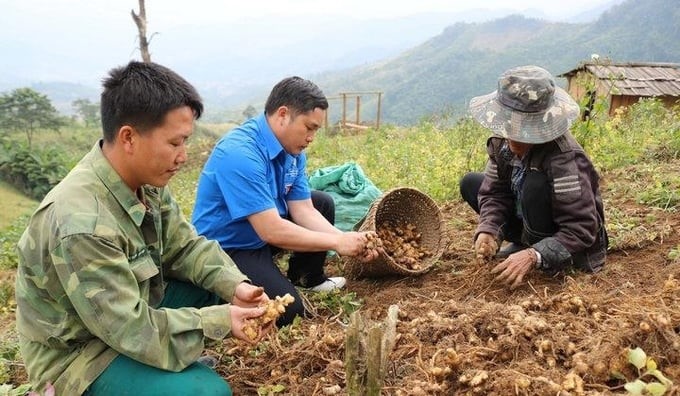
Ginger has created jobs and income, helping hundreds of households in the Ky Son Highlands escape poverty. Photo: Lu Phu.
With acumen, passion, and dynamism in the market mechanism, Mr. Nguyen Van Luan has become a model in production and business in the Ky Son highland district. The work of the Cooperative and Mr. Luan personally has created motivation for villagers to feel secure in producing ginger, especially in the current ginger production and consumption linkage between the Cooperative and villagers in four communes of Ky Son district and two communes of Tuong Duong district. Not only that, the Cooperative also creates regular jobs for 13–15 workers in Ky Son district with stable income (average VND 6–6.5 million/person/month).
As for Mr. Nguyen Van Luan personally, in 2021, he was awarded a certificate of merit by the Ministry of Planning and Investment. Recently, Mr. Luan was also awarded the title of “Good Veteran in Production and Business” at the provincial level in 2022 by the Nghe An Provincial Veterans Association.
However, the success in which Mr. Nguyen Van Luan is most interested is that he has contributed to helping hundreds of highland farmer households escape poverty, which is highly appreciated by the Ky Son District People's Committee. Most importantly, the Ky Son Ginger product has become a brand that is present in domestic and foreign markets.
Translated by Huyen Vu Thu

(VAN) The trade turnover of agro-forestry-fishery products is growing significantly, along with investment cooperation commitments that are opening up new development directions between Vietnam and Russia.
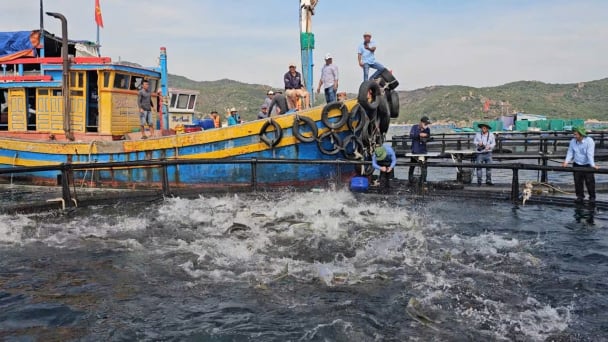
(VAN) Khanh Hoa is investing over 545 billion VND to develop 240 hectares of high-tech marine aquaculture in order to guarantee a consistent supply of seafood exports and achieve the USD 1 billion target.
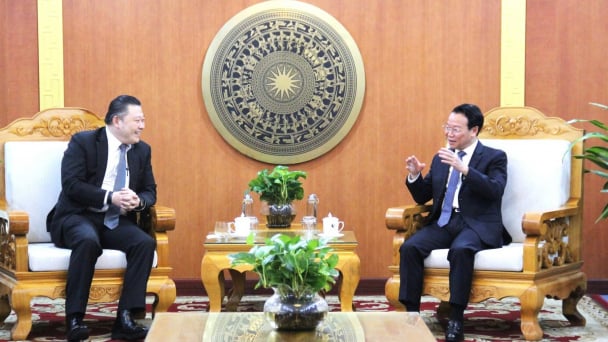
(VAN) Minister of Agriculture and Environment Do Duc Duy held a meeting with Soopakij Chearavanont, Chairman of C.P. Group, on May 15.
/2025/05/16/3800-0-nongnghiep-143756.jpg)
(VAN) Suntory PepsiCo Vietnam coordinated with the Ministry of Education and Training to implement an education program on water conservation, reaching nearly 1 million primary school students nationwide.

(VAN) Vietnam’s TH Group officially put its high-tech fresh milk processing plant into operation in the Russian Federation, marking a historic moment as the first TH true MILK cartons were produced in Russia.

(VAN) Use of high-quality broodstock and biotechnology is regarded as the most effective approach to ensuring sustainable and economically viable shrimp aquaculture ahead of climate change and the emergence of increasingly intricate disease patterns.

(VAN) Carbon farming is a form of agricultural practices that helps absorb more greenhouse gases than it emits, through smart management of soil, crops, and livestock.